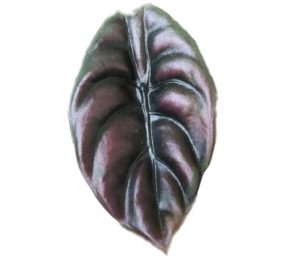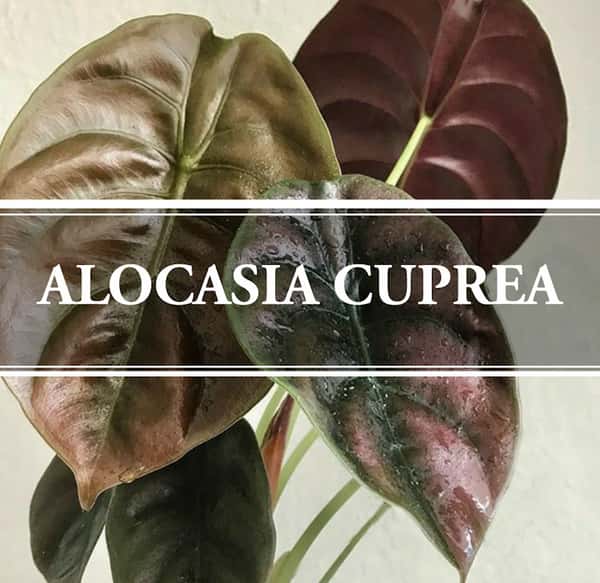Plants with bright foliage always attract love and admiration. Seeing a healthy and well-grown plant with some nice foliage around is nothing lesser than a treat to the eyes. Today, we are introducing another such plant, the Alocasia cuprea plant.
This is a proud member of one of the most beautiful type collection in the genus, the Jewel Alocasias. The large heart-shaped leaves are bright green with coppery hues, lighter veins and reddish undersides.
The name cuprea is also derived from the unique coppery hues of the foliage. Moreover, these leaves have a typical metallic sheen which refers them to be popularly known as the Mirror Plants. Different varieties of the plant further enhance the collection by showing slight variations in the foliage. Let us learn more about the care and propagation of this native of Borneo, the Cuprea Alocasia Plant.
Alocasia Cuprea Classification
Family: Araceae
Genus: Alocasia
Species: A.cuprea
History
It was Thomas Lobb, who brought the specie to Veitch Nurseries of Europe in the middle of 18th century.
Interestingly, this plant was pretty famous in the later years of the 18th century.
Genus Alocasia
Alocasias are flowering plants with bold foliage. About 70 different species with an ever-increasing quantity of cultivars comprise the genus. Alocasia amazonica and Alocasia macrorrhizos are among the most famous members of this genus.
Alocasia Cuprea Common Names
Apart from the scientific names of the plants, people use common names for the plants. These names are typically given due to some prominent feature or the foliage of the plant.
- This is amongst the famous type of the Alocasias, know as the ‘Jewel Alocasia’. The name refers to the prominent and shiny foliage including a large number of Alocasias.
- Another common name associated due to the shiny plastic-like foliage is the ‘Mirror Plant’.
- The Reddish hues in the leaf surface refer to the name Alocasia cuprea Red Secret.
- It is also known as Alocasia cuprea Red.
Features of the Alocasia Cuprea Plant

Height and Structure
This plant remains short as compared to other siblings. The mature plant grows under 2 feet.
Leaves
Alocasia plants are famous for their prominent heart-shaped or elephant ear-shaped leaves. The leaves of a mature plant get from 1 to 3 feet in size. Yes! The size of the leaves can even outgrow the overall height of the plant.
Toxicity
Just like other Alocasia plants, this peep is toxic as well. Close contact and ingestion May lead to health issues like skin allergies or ulceration of mouth and oesophagus. So, keep the plant away from kids and pets.
Dormancy
The plant starts shedding leaves and showing slow or minimal growth in low temperature. Howbeit, this dormancy is controllable. Keep the plant in a warm place with a temperature above 60 F and it will stay fresh throughout the year.
Varieties
The plant comes in different varieties or cultivars, mainly showing differences in the shades from copper to red. The parent plant is known to have coppery hues.
- Another popular variety lacks the coppery hues and the leaf surface shows lesser veins. However, this typical variety grows a large number of leaves per plant at a time. The inflorescences of the plant have wine-red spathes and off-white spadices.
- There is another variety with greenish leaves, know as the ‘Cuprea Green’. These have greener spathes and off-white spadices.
- Another rare variety with reddish black leaves is also seen in records.
Alocasia Cuprea Care
This peep is quite easy to grow as compared to the majority of Alocasias.
Quick Guide
Water: Medium Requirement and Watering right after the soil upper 2 inches of the soil get dry.
Light: Medium to the bright indirect sun.
Humidity: High.
Fertilizer: Diluted form in the growing season.
Let us have a deeper look into the important steps you need to keep these shiny peeps happy.
Water Requirement
The water requirement of the plant is average. Water the soil and let the soil dry out before you water again. Make sure you let the soil get moist without soaking it heavily. You can check the soil by inserting some stick or your finger. If it comes out moist, it means the soil doesn’t need water. Alternatively, the dryness in the upper 2 inches of the soil indicates you to water.
You need to learn the watering frequency for your plant. Generally, about twice to thrice a week is enough in summer. On the other hand, the water requirements decrease with the decrease in temperature and sunlight availability. Moreover, about once in every ten to fourteen days is enough for the fall and winter.
The plant has poor tolerance for droughts. Similarly, it can’t withstand over-watering. Soggy soil can lead to serious issues like root rot or fungus of the foliage.
Sunlight Requirement
Medium to bright indirect light keeps the Mirror Plant healthy. Under-lit places can make the plant lose the chlorophyll which one goes unnoticed can kill the plant. Besides, direct sunlight can also kill the plant by scorching out the foliage. Thus, select the place smartly.
Temperature Requirement
The mirror plant likes to grow slightly cooler, as compared to its siblings. The ideal temperature for your plant ranges between happy ranges from 54 °F(12 °C) to 85 °F(29 °C). At the day time, the best range starts from 50 °F(10 °C), while the temperature should be above 54 °F (12°C) at night.
These peeps have poor tolerance for cold and frost. So, don’t forget to transfer them to some warm spots before the fall. This is specially important for outdoor plants.
Soil Requirement
Well-drained and quick-drying soil with plenty of aeration is what goes well with the Alocasia cuprea Plant. The growing mixture should not hold on to extra water. Excess of water prevents the oxygen from reaching the roots which ultimately leads to root rot.
You can use a mixture of Coir Fiber and perlite. Coir is made up of coconuts and is quite rich with plenty of nutrients. Moreover, it is costly as compared to peat moss which can be used as a cheaper alternative. Both of these are neutral in PH. On the other hand, perlite is a minced volcanic rock and is quite light in weight. Although it can hold around 3 times its weight in water, it doesn’t let it stand for the roots. So, all these ingredients provide aeration and quick-drying for the plant.
Humidity Requirement
These plants, being the natives of tropical lands, love to stay in high humidity. Ideally, a moisture level of 80% and above is required to keep the plant happy. Some people keep them in bathrooms and the plants love them for it.
If your surroundings are not humid enough, specially in fall and winter, you need to adjust it. There are different ways to enhance humidity.
Grouping the plants
Plants placed in groups have a general higher amount of moisture available in their surroundings. You can place a few plants together to make sure the humidity level is maintained.
Pebble-water tray
Secondly, you can use a pebble filled tray. Simply, fill a tray with pebbles and fill it with water keeping the water level below the upper surface of pebbles. Now, place the plant pot on the pebbles. Make sure the water doesn’t touch the pot or enters the soil through the drainage hole. This setup will enhance the moisture for the plant.
Humidifier
You can also use a room humidifier to help you maintain the desired humidity level.
Fertilizer Requirement
These peeps are heavy feeders. Use a common houseplant fertilizer in liquid form. Moreover, it is preferable to use half of the quantity stated on the pack. This will help you to avoid over-fertilization which is quite harmful to the plant. Give a monthly or bi-monthly dose during the active growing state in spring and summer.
The nutritional requirements of the plants decrease in low temperature. Thus, strictly avoid fertilizing after the fall.
Pot Requirement
Use a common average size pot with drainage holes at the base.
Repotting Requirement
The plant will be happy in the same pot for about two years. After this period, I will look considerably bigger than the pot showing you need a bigger one. Choose a pot slightly larger than the current one. Spring is the ideal time to repot.
Growth Zones
The majority of Alocasias are hardy in USDA Growth Zones 3 to 11.
Alocasia Cuprea Propagation
Division of roots is the ideal method for the propagation of your Cuprea Plant. Stem and leaf cuttings don’t even show considerable results for this plant.
Season
Middle of the spring until the middle of the summer is the ideal time. Howbeit, you may propagate the plant up till the end of the summer.
The ideal time for propagation starts from the middle of the spring until the middle of the summer. However, you may propagate by the end of summer as well.
Method
- Take a well-grown plant and loosen the soil around the base. Very gently, take the plant along with the roots without damaging them.
- Now, shake the plant gently. This will remove the excess soil.
- Sometimes the plant produces baby plants or pups, which are attached with the parents through the roots. These can be separated by slight shaking. If you are unable to find any pups, you can simply cut the roots.
- Take sterilized gardening shears and cut the 1/4th of the plant along with the roots. Make sure there are at least three shoots on the divided plantlet.
- You can sterilize the shears by isopropyl alcohol. Just make sure you make a few snips after cleaning the shears. Importantly, keep the kids and pets away from your surroundings to avoid any unfavorable circumstances.
- Now, plant both of the parts to their desired pots.
- Place the setup in a warm and humid place with indirect sunlight.
Water Propagation
- You can also plant the divided plants into the water.
- Just take a jar and fill it with water. If you are using the tap water, let it stay overnight. This will allow the chlorine and other toxic chemicals to evaporate.
- Dip the roots in the water keeping the shoot at the top.
Growth- Timeline
Let us look at the growth time-line to let you have a better understanding of the propagation process.
Day 1 to Day 60: Use a spray bottle to water the soil right after if gets about 90% dry. Spay mildly and don’t overwater.
Day 60 onward: Now, you can simply follow the instructions mentioned in the previous section. This will help you with all your questions about How to grow the A. cuprea plant. This plant is a quick grower and soon you will get a well-growing baby Mirror Plant.
Related posts:
Summary
The Alocasia cuprea is a native of humid areas, Borneo in particular. The plant grows up to 1 foot with large elephant ear leaves. These leaves are bright green with lighter veins and shiny surface.
The glossy surface of the leaves makes it commonly known as the Mirror Plant. You will rarely find it in wild. Moreover, it loves to grow indoors in pots and containers.
This is a relatively low-maintenance plant. Indirect light, high humidity and watering after the soil gets dry is all this Jewel Alocasia needs. Make sure the attractive foliage doesn’t make you forget its toxicity. Keep your kids and pets away from mingling with the Cuprea plant.

